Arts and crafts
Palekh
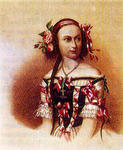 The unbelievably colorful art of Palekh is known in all countries of the world. The elegant black-lacquered art pieces on which the heroes of Russian folklore come to life - the amazing fire-birds and the gold-manned troikas subjugate us with fairy tale-like world of beauty, movement and harmony of their color chords. The unbelievably colorful art of Palekh is known in all countries of the world. The elegant black-lacquered art pieces on which the heroes of Russian folklore come to life - the amazing fire-birds and the gold-manned troikas subjugate us with fairy tale-like world of beauty, movement and harmony of their color chords.
The village of Palekh is stretches widely out among the woods and fields in a picturesque corner of the Ivanovo county. In the XV century it was a part of the Vladimir-Susdal lands and was one of the first ancient centers of icon drawing trade. In the XVII-XVIII centuries Palekh's craftsmen became the most famous in the icon business. They worked out a style all of their own which can be distinguished by the fine line tempera drawing saturated with gold. Their work was valued for the depth of its images and for their fairy-tale-like ornamental design.
After the 1917 bolshevik's coup, when the icon business went down, Palekh masters tried to decorate wooden toys, dishes, porcelain and glass. But the most interesting way turned out to be painting black-lacquered boxes made of papier-mache by the likes of E.Golikov, E.Vakurov, A.Kotukhin, and E.Bakanov. Those masters along with some of their fellow villagers established, in 1924, a shop of ancient art in which a new kind of folk art was born-the Palekh artistic lacquers. By the end of 1920`s there was a wide assortment of Palekh art objects. Beautiful by their proportions, elegant by form, the little jewelry boxes, bead boxes, and powder cases beamed with bright colors and sparkled with golden decorative patterns. Ordinary things were transformed into objects of art in the hands of talented artists. Ancient hunting scenes and battles from Russian epics, village scenes and prayers, literary plots and the joy of work - everything was reflected in the art of these distinctive artists. In their art they embody the folk culture. They are inherent of the passionate feeling of life and modernity. The art of Palekh miniatures expresses the true national character. Many examples of Palekh art have received recognition at international exhibitions and have become world-known.
Arts and Crafts
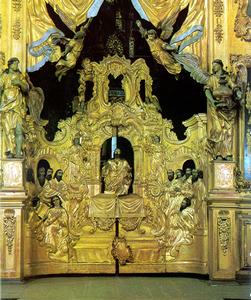 Characteristic feature of the Russian decorative art is its mass character and "co-operation". The Russian decorative art is mainly 'anonymous', we know the names of firms rather than of artists (Gambs' furniture firm, Charles Faberzhe's jeweller firm). Wall painting, weaving, anonymous masters working under the projects of great architects, created masterpieces of Russian interior. In the 20th century of constructivism creative art of such inventors of a new world of things as Vladimir Tatlin and Lazar Lisitsky became popular. But the Stalin regime replaced men of genius by state monopoly and 'tyranny of deficiency'. Nevertheless Russian art created many valuable things in many fields. Characteristic feature of the Russian decorative art is its mass character and "co-operation". The Russian decorative art is mainly 'anonymous', we know the names of firms rather than of artists (Gambs' furniture firm, Charles Faberzhe's jeweller firm). Wall painting, weaving, anonymous masters working under the projects of great architects, created masterpieces of Russian interior. In the 20th century of constructivism creative art of such inventors of a new world of things as Vladimir Tatlin and Lazar Lisitsky became popular. But the Stalin regime replaced men of genius by state monopoly and 'tyranny of deficiency'. Nevertheless Russian art created many valuable things in many fields.
First developed forging and jewelry making refer to the time of Scythians and related tribes that lived in the territory of the Black sea, Chernozem region and Siberia. Characteristic feature of arts of people who lived in these territories is so-called Scythian 'animal' (teratological) style. As the Northern Slavs came in touch with the Baltic and Scandinavian tribes they adopted another variant of 'animal' style in which ornament includes parts of animal and human bodies binding with each other whimsically. In the Ural, the Finno-Ugrian tribes made amulets decorating them with stylized images of bears and wolves, first materials they used were wood and stone and only then bronze. Ladles cut out from wood and decorated with the heads of elks, deer and ducks are famous for plastic expressiveness. These traditions had been long kept in the Russian folk art.
For many centuries up to the twenties of the 20th century, handicraft provided villages and towns with clay, wooden and metal utensils, wooden and ceramic toys, print, carpets and other things. Khokhloma wooden utensils, bright and cheerful wood painting, Dymka clay figures and penny whistles, Lukuta varnished and painted caskets became especially popular.
Remarkable crafts were developed by peoples of the Russian North, Siberia, the Far East, and the Caucasus. Crafts of Dagestan auls are also known, among them Kubachi (processing of metal), Balkhar (painted ceramics), Untsukul (silver notching made on wood).
In Soviet times former icon-painting workshops went over to painting caskets. In Palekha (Ivanovskaya oblast) I.I.Golikov and other craftsmen developed delicate miniature painting on black varnish with elements of fairy tales and national songs. In ancient times Russia adopted the art of barrier and black enamel, metal stamping, bone and wooden fretwork from Byzantium. By the 17th century there had been formed developed art manufacture: Rostov and Usol painted enamel, Veliky Ustyuzh silver blackening, Nizhny Novgorod fretwork on log huts. Works of the decorative art decorated temples and palaces.
During the time of Peter the First ruling things of the West-European type came into use, such as faience, cast and stamped utensils, upholstered furniture. In the 18th century mirrors were first used. In the 18th century M.V. Lomonosov arranged manufacturing of glass, mosaic smalt and mirrors. The best architects of the 18th and the beginning of the 19th century created sketches of decorative furniture elements. A number of architects, such as Rossi, Voronikhin worked as a decorator at first. Private enterprises that worked masterly in the 19th century carried out orders of the imperial court and aristocracy. The most famous trade-marks of that time were Popov's porcelain plant, Kuznetsovs' faience and porcelain factories. At the end of the 19th and the beginning of the 20th century Savva Mamontov from Abramtsevo and Klavdiya Tenisheva from Talashkino united professionals and national craftsmen to restore the traditions of the Russian folk art. Elena Polenova, Nikolay Rerikh, Michael Vrubel took part in this work. During the development of modernist style majolica, Vrubel's stained-glass windows, furniture made on sketches of Shekhtel, Fomin and Shusev determined a new rise in Russian decorative art.
In early time of the Soviet power establishment of Higher Art & Technical Workshops; new ideas of art manufacture; new wooden and metal products created by Tatlin and Lisitsky; L.Popova's and V.Stepanova's fabrics attached world importance to the works of Russian artists and designers. They exerted a great influence on the process of design art development in the 20th century.
"The great crisis" in 1929 interrupted the development of design art in Russia. When in 1945 first trophy things from Germany were supplied, poverty of the Soviet life, on the one hand, and failure of bringing-up "people of new formation", tolerant to "beautiful life", on the other hand, became obvious. Probably, it was one of the reasons of "burst" of interest to design that took place with the beginning of Khrushev's 'thaw" period.
Artists created amazingly beautiful and unique products: one can enumerate the names of such masters, as Boris Smirnov, Vladimir Olshevsky (glass and ceramics), Vera Mukhina, Galina Antonova, Svetlana Beskinskaya (glass), Peter Leonov, Vladimir Gorodetsky (porcelain), Alexandra Zabelina, Sulamif Zaslavskaya (fabrics).
At the beginning of "perestroika", high-quality foreign products (both mass, and elite) were imported, that's why there was urgent necessity of Russian industrial design development.
Abashevo Penny Whistle
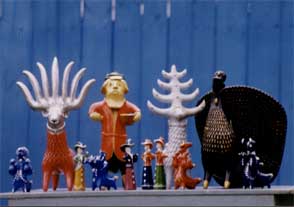 Abashevo settlement of Penzenskaya oblast is an ancient Russian village with deep historical, religious and art roots. Abashevo settlement of Penzenskaya oblast is an ancient Russian village with deep historical, religious and art roots.
It was first mentioned in books dated back to 1616, which were written by scriveners who lived in Shatsky uyezd. This village was inhabited by barins, so well-known people owned it, among them Ivan Pyzhov and prince Golitsyn.
Namely pot and pipe makers made Abashevo settlement famous. More than half of the inhabitants made various kinds of utensils from kaolin and modeled penny whistles. In the 19th and 20th centuries Abashevo was the leading Russian centre of ceramics. Toys made of clay were exhibited in Moscow, London and Paris. They have traditional patterns: pets, birds, deer, horsemen, landowner's wives are portrayed from generation to generation, every craftsman puts his heart into these images, therefore there appear unique vivid personificated ones. 162 manufactures were engaged in it.
The secrets of modelling and baking were kept from generation to generation, from fathers to their sons. Children were taught this craft at the age of 8. Thus there were the whole dynasties of potters and pipe makers.
In the old days things made of clay were baked in furnaces, facilities of round or oval shape bricked with 1,5 m wide and 2 m high fire-bricks. Foreman had to get into a furnace, and his wife gave him jugs and pots top-down. The top of products was faced with 'kalanchiks', peaces of broken utensils. Earthenware was burnt with birch or oak firewood. After it had been burnt it was traditional to bake potatoes.
Curative clay used for modeling of Abashevo toys, and kindness of a foreman relieve feelings and protect families from evil spirit.
All penny whistles are made individually for protective purpose.
Every Abashevo penny whistle has its certificate with the date it was manufactured signed by a foreman!
It is made of thick calendered cardboard, all inscriptions being made in silver paint.
Wonderful Abashevo toys do not leave anyone indifferent, no matter whether it's a laboratory visitor or a local inhabitant. Besides there are a lot of poems about Abashevo village in Russia.
Contact:
'Alan' company, representative of Abashevo folk art.
22 Bogdanov St., Penza, Penzenskaya oblast, Russia
Kalashnikov Andrey Viktorovich
Bogorodskoe Toys
 Wooden carved toys as well as clay ones created by national craftsmen in Bogorodskoye village of Moscovskaya oblast belong to national plastics and can be used in work with children on lessons of decorative modelling.Woodcarvers have been living there for more than 300 years. Whole families work here. Now there are about hundred carvers in this village. Wooden carved toys as well as clay ones created by national craftsmen in Bogorodskoye village of Moscovskaya oblast belong to national plastics and can be used in work with children on lessons of decorative modelling.Woodcarvers have been living there for more than 300 years. Whole families work here. Now there are about hundred carvers in this village.
Toys are cut from linden. Before it turns into a toy, it should get dry for two years. Splinter, linden wastes are also used for cutting of smaller toys and supports to them. Bogorodskoye toys are more often not painted and seldom decorated.
Statuettes are cut from the whole tree for which different forms of timber are prepared. If one is about to cut a bear sitting on a support, procurement is of a triangular form. A surface of finished products was smoothed out with emery paper. The whole surface of a toy was usually cleaned out, in the result of which a statuette was smooth. As women and children carried out this work, original plan very often became obscure.
Now toys are decorated with fretwork that covers their surface and decorates them. According to a tradition some parts of a toy are made movable. It is achieved by various means. Some toys are fastened on supporting pedestals, and spring setting toys in motion is inserted inside them. Other toys are made on swinging laths("Herd", "Cavalry", "Soldiers"). It is possible to come across such toys, movable parts of which are attached to threads with a heavy object, the latter is swinging and presses down a thread which sets in motion parts of statuettes.
All toys have different features: elements of fairy tales, fable, sports and space, and all of them are funny. The image of bear is traditional, it is portrayed to be a quiet, kind and ridiculous animal holding either a basket of mushrooms and raspberries, or an accordion, sometimes it is depicted being deceived by a cunning man. All toys are made with a good sense of humour.Bogorodskoye toys makers perfectly feel plasticity of form. There is nothing superfluous in funny toys, besides they look like caught in a movement.
Dymkovo Toys
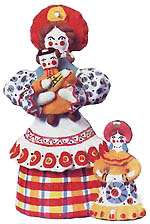 Dymkovo toys, a unique phenomenon in Russian folk art, are among the most popular works of folk craftsmen of Russia and all over the world. For many decades folk art exhibitions have invariably included the colored clay figurines and figure compositions. Dymkovo toys, a unique phenomenon in Russian folk art, are among the most popular works of folk craftsmen of Russia and all over the world. For many decades folk art exhibitions have invariably included the colored clay figurines and figure compositions.
The origin of Dymkovo toys goes back to ancient times, and is linked with the local festival of the Vyatka province, Svistoplyaska ("whistle-dance", dancing with and to whistles). The festival included commemoration of the ancestors, rolling clay balls down a steep slope of the river, play-fights, promenading and also rich bazaars selling sweets, nuts but mainly clay toys and whistles made by thousands in Dymkovo specially for the occasion.
The chief manufacturers of toys were women and children, who worked seasonally first, and later throughout the year. There were three types of clay toys, balls, whistles and dolls. The first two are of ancient origin connected with the heathen symbols of fertility, which must also account for the prevalence of women with children, domestic animals, and fowl among the figurine motifs.
With the passage of time pagan symbols gave way to everyday themes, and clay balls and whistles were substituted by figurines and groups that decorated window sills, cabinets like fashionable china.
However, still rooted in ancient traditions, Dymkovo toys were not imitations of porcelain, they developed into an original art, vital and always up-to-date. The toys prospered on new themes and subjects taken from life and, at the same time, modified by people's imagination.
Thus, a new world of Dymkovo toys was formed, with tradition and imagery of its own; new artistic media and standards became established, that were characteristic of the new art throughout its development.
Dymkovo toys appeal to our contemporaries by their artistry, clear-cut characters, witty humor and optimism. These are the traits that make this original art superior to time.
Easter Eggs
 From time immemorial an egg has been the object of religious adoration. Practically, all highly developed nations are well aware of symbolic significance of an egg illustrating transition from non-existence to life; it-s a symbol of joy, happiness and sun which brings warmth and revival of the nature. In the ancient language of Egyptian hieroglyphs the determinative sign of an egg displays a certain potential, a life-giving seed, a mystery of being. From time immemorial an egg has been the object of religious adoration. Practically, all highly developed nations are well aware of symbolic significance of an egg illustrating transition from non-existence to life; it-s a symbol of joy, happiness and sun which brings warmth and revival of the nature. In the ancient language of Egyptian hieroglyphs the determinative sign of an egg displays a certain potential, a life-giving seed, a mystery of being.
The use of colored eggs also has deep roots going deep to the past centuries. This tradition was known in China, in Ancient Greece and in Rome. As for the Orthodox Easter traditions, the colored egg has always been one of the main symbols of Easter. There are two types of Easter eggs mostly used in Russia: "pisanki" v richly ornamented eggs of two, three or four colors, and "krashenki" v Easter eggs of one color, without any ornament. In compliance with ancient traditions Russians mark the celebration of Easter with presenting colored eggs to each other.
This tradition was also very popular with the Russian ruling house; the colored eggs were presented to boyars and Russian nobility.
In addition to natural eggs, there were extensively used eggs made of different materials and richly ornamented. By the beginning of the 20th century Easter eggs making had turned to be an independent branch of Russian decorative and applied arts.
A special place is occupied by porcelain eggs, which were specially ordered by the Russian Tsars at the Emperor Porcelain Manufacture. They are of high artistic value and perfection and are viewed at present as popular antique objects and Russian souvenirs.
Elets lace
Elets lace is a kind of Russian lace tatted with bobbins, the centre of it is Elets city in Lipetskaya oblast. It is famous for its contrast of small graceful pattern (containing both vegetative and geometrical figures) and thin openwork background. In 1960 Elets manufacture was founded, which since1974 has been known as Industrial Association 'Elets lace'.
Elets lace has been known in Russia since the end of the 18th century. In one of the centres founded in Elets the Russians began to master the art, which had come to us from Europe. It is known that hundreds of people who lived 25 verst off Elets district began to master not an easy craft at the beginning of the last century already. At first masters used foreign patterns, but in the course of time craftsmen acquired their own style, which is characteristic of Elets lace nowadays.
The first time Europe saw wonderful Elets lace was in 1873 in the world-wide exhibition which took place in Vienna; the lace made by our masters drew everybody's attention and was highly estimated by experts. Elets lace received different awards, medals in the world-wide exhibitions which took place in Paris, Brussels, Montreal, Osaka. For the last ten years Elets beautiful lace has been exhibited in the 120 international exhibitions, every time causing everybody's admiration. And in 1994 in Moscow exhibition lace was awarded a golden medal. Traditionally they are sold both in Russia, CIS and in foreign countries.
The modern firm "Elets lace" consists of about one thousand of people who work in workshops, and craftsmen working at home. They use new decorative solutions and technological methods, but old traditions of bobbin lace tatting are not forgotten. Besides, best samples of Elets lace are kept both in collections of leading museums of folk art, and in private collections. Nowadays there are about 200 kinds of 'Elets lace". Among them there are things embroidered in stitch, produced in a special workshop, and separate things made by hand unique from the point of view of originality and the way of embroidery. By the way, Elets citizens tat lace to order. Lace was always in fashion. It is imperishable like any art. Would you resist beautiful, originally made up-to-date bed-clothes or decorating your clothes with wonderful lace? Such details as lace add some style and originality to our appearance. 'Elets lace' firm has many constant partners. The manufacture interests new business partners in their production both in Russia, and in foreign countries. They are always ready to listen to any business proposal.
Fedoskino miniature painting
 The village of Fedoskino, one of the centers of modern Russian lacquerwork, is located in picturesque surroundings of Moscow, on a bank of the Ucha. Fedoskino is a very old village; about two hundred years renowned for its miniature paintings on lacquered papier-mache boxes. The village of Fedoskino, one of the centers of modern Russian lacquerwork, is located in picturesque surroundings of Moscow, on a bank of the Ucha. Fedoskino is a very old village; about two hundred years renowned for its miniature paintings on lacquered papier-mache boxes.
This art has been known in Russia since the late eighteenth century when in 1795 the Moscow merchant Piotr Korobov opened his workshop in the village of Danilkovo, opposite of Fedoskino across the River Ucha. Soon the Fedoskino painted boxes became popular and famous in Russia and in Europe. Practically, the production of lacquered papier-mache articles with painted decoration has not changed significantly since the mid-nineteenth century.
A characteristic feature of Fedoskino miniature painting has always been a combination of direct painting with glazes superimposed over a goldleaf, mother-of-pearl plaque or over a ground powdered with metal dust. A technique of pure glazing is also used: glaze, a transparent layer of paint, is applied all over another color or ground, so that light passed through it is reflected back by the under-surface and modified by the glaze. Coats of varnish are applied to every layer of paint. The exteriors of boxes, tea-caddies and other household utensils were often worked in imitation birchbark, malachite, ivory and tartan. The interiors imitated mahogany and tortoise-shell and are lined with white foil.
Today the articles are painted with a great variety of subjects on genre, literary, song, fairy-tale, historical and contemporary life themes. But even a short acquaintance with them helps one to go deep into their art, which is an art unique, with strong national roots and the traditional decorative quality, which gives it its originality
Finift
 The tradition of miniature enamels goes back over two full centuries in Rostov (the Great), a small town not too distant from the great Volga River. The earliest mention of enamel craftsmanship in Rostov is 1760. It is clear that even then, the art had been in practice for some time. Enamel in Russia is first mentioned in the reign of Duke Andrei of Suzdal, where it is chronicled in 1174 that the Church of the Nativity was decorated with "gold, enamel, and all type of virtue." This superb artistry, passed from generation to generation, exemplifies the Russian artistic style. Rostov enamels have had various stages of flowering and decline, but the main theme of this craft - a tribute to the beauty of Russia's native land and to man's eternal spirit - was never lost. The tradition of miniature enamels goes back over two full centuries in Rostov (the Great), a small town not too distant from the great Volga River. The earliest mention of enamel craftsmanship in Rostov is 1760. It is clear that even then, the art had been in practice for some time. Enamel in Russia is first mentioned in the reign of Duke Andrei of Suzdal, where it is chronicled in 1174 that the Church of the Nativity was decorated with "gold, enamel, and all type of virtue." This superb artistry, passed from generation to generation, exemplifies the Russian artistic style. Rostov enamels have had various stages of flowering and decline, but the main theme of this craft - a tribute to the beauty of Russia's native land and to man's eternal spirit - was never lost.
Enamel is one of the oldest forms of decorating metal. It is a vitreous substance, meaning that it resembles and takes on the characteristics of shiny, glossy glass - such as the "vitreous" appearance of the human eye. Rostov enamels shine stunningly with subtle hues in jewelry pieces produced by today's craftsmen. These miniature enamels are often framed with intricately twisted "filigree" of sterling silver on copper, which compliment the exquisite enameled miniatures. Unlike tempera and oil paints, enamel never loses it color! They always remain as bright as the moment the plaque appears from the furnace after being "fired."
The art of enameling is known to exist in the Kievan Rus back in the 11th Century when it was referred to as "o Finift", Old Greek for "alloy", or "shining stone". Rostov is known to have had an icon painting workshop since olden days, hence when icon painting began to wane, the artisans transferred their expertise to enameling. In the late 18th Century floral designs came into use, expressing feminine elegance. These hand-painted enamels were often painted with a single hair brush, and this technique is continued today! Though a history of enameling in Russia can be found in various regions, Rostov stands as the pinnacle. Earlier, Rostov enamel craftsmen were commissioned to inlay icons, chalices, Bibles and even monarch's crowns. Today, the technique is used chiefly in jewelry making.
Glyptics
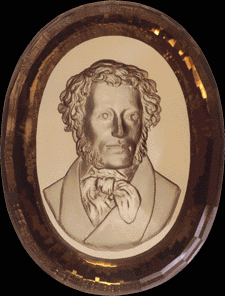 Glyptics is the art of precious and semiprecious stone carving known since antiquity. But it reached its fullest flower in the culture of the ancient world. Glyptics is the art of precious and semiprecious stone carving known since antiquity. But it reached its fullest flower in the culture of the ancient world.
One of the archaeologists of the 19th century called relief cameos carved on extra-hard minerals 'stone painting'. Long ago, up to Alexander Makedonsky's Eastern campaigns (the second half of the 4th century B.C.) masters preferred to make deep carving and created miniature relieves in loam and wax. The first cameos were cut form one-colour material, such as garnet, jacinth, amethyst:Bright 'cheerful' combination of flickering stones and brilliant gold rim attracted everybody's attention.
But very soon carvers went over applying multi-layered minerals what let them use more colours and tints for creation of different shades. The first cameos made of multi-layered agates were carved in Alexandria, at Ptolemeys court (the end of the 4th - 3d centuries B.C.). Many of them were too big to be stamped and used as an amulet. Things made of such agates to order served as regal gifts in temples or were decoration of luxuriant head-dresses of rulers.
An agate is harder than steel, that's why carvers had to use harder minerals as an abrasive. Turning dusty corundum or a diamond was cutting into the surface of a stone and carved a picture. Like constant dropping wears away the stone, an abrasive peeled off an agate. Intricate interchange of coats appeared in the course of work, so it was impossible to change anything. So carvers performed a real feat. Large cameos resemble 'agate pictures' and craftsmen spent several years on them. The archaeologist E.Bablon said that creation of a big cameo required as much time as the creation of a Gothic cathedral. For example, in the 19th century the carver A.David spent 15 years to make the cameo 'Napoleon's triumph'!
The difficulty of work was that dusty abrasive covered the whole picture and a foreman had to work from memory, almost at random. To look at the best ancient cameos we can see that an experienced craftsman managed to overcome these difficulties so that perfect samples reminded good paintings in which all the chatoyant colours and contrasts of dots seemed natural in the mineral itself.
Ancient masters often used either an Arabian sardonyx with its colour scheme of cold grey and blue colours or an Indian one in which warm brown and red tints prevailed. Anonymous Alexandria carvers of the 3d century B.C. employed all decorative means, they made their works plastic, expressive and colourful so that they became masterpieces of Hermitage's collection.
Buffing the surface of a stone in different ways they made a helmet shimmer like metal and human face preserve dulling of flesh:.Changing the thickness of the mineral's upper light coat a craftsman like a painter who uses glaze techniques made the lower dark coat appear through it. It made an impression of light and shade modeling, with the help of tints a colour scheme of two- and three-coated agate and sardonyx was constantly enriching.
Glyptics is the oldest art of stone carving which got its rise nowadays. In the course of time this kind of art was meant only for rich people, connoisseurs of art.
Oleg Galatin, like some of his few colleagues have no followers. A circle of potential exquisite miniatures owners is not large. The creative work of Oleg Ivanovich, glyptics, is the art of precious and semiprecious stone carving. Oleg Galatin is one of few today's masters busy with this craft. The master's gemmas are often exhibited in foreign countries: Germany, Singapore, Hungary. A number of the masterpieces are kept in Kiev museums, Saint-Petersburg Hermitage, the Armory Museum in Moscow Kremlin, the Municipal Florentine Museum and private collections.
Blue aquamarine, smoky topaz or rock crystal perfectly fit in necklaces, ear-rings, brooches and rings. You can be sure it is the author's work. It is unique!
An exclusive Galatins'work is A.S. Pushkin's portrait.
Entail on cut topaz of 1999 year. 1550 carat. 98õ75 mm. The stone is of wine colour. Hardness according to Moos is 8, refractive exponent is Ng-Np 1.610-1.638, dispersion is 0,014.
It belongs to unique works of art.
Expertise is N 25/A of March, 13, 1999.
Those who had ever seen this stone, or held it in his arms, are impressed by its beauty and size. It is magnificent because of its striking coldness, warm colour and harmony:
Ice and flame! Unforgettable impression!
Golden Khokhloma
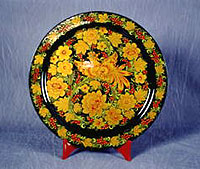 Along the banks of the Volga River, there is a village called Khokhloma (pronounced: HOK-la-ma). It is surrounded by forests of aspen and birch trees. Over 300 years ago, the villagers found that their growing community could not sustain itself with the limited crops they were able to grow. Rather than cut down their beautiful forests to make room for more farm land, they came up with a way for the trees to provide them with an exportable product. This export was, then, traded for food and other goods. The product was wooden utensils crafted from the local trees. Along the banks of the Volga River, there is a village called Khokhloma (pronounced: HOK-la-ma). It is surrounded by forests of aspen and birch trees. Over 300 years ago, the villagers found that their growing community could not sustain itself with the limited crops they were able to grow. Rather than cut down their beautiful forests to make room for more farm land, they came up with a way for the trees to provide them with an exportable product. This export was, then, traded for food and other goods. The product was wooden utensils crafted from the local trees.
Khokhloma became a trading centre in the Transvolga region. It became quickly known for its unique, hand crafted wooden items. It is said that Boyar B.I. Morozov ordered large quantities of Khokhloma's cups and eating utensils and had them shipped to Moscow in the 17th century.
As the residents of Khokhloma were developing their wood working skills, nearby painters discovered a new way to process beautiful, yet permanent, painting techniques. By using tin, extreme heat and lacquer, they were able to create the appearance of a gilded gold finish. The painters and wood crafters joined their talents to produce Golden Khokhloma.
The craft is still practiced today, using the original techniques and elements. First, seasoned soft wood is hand carved to create spoons, bowls, cups, vases, small pieces of furniture and ornaments. Next, the pieces are dried in a kiln, then covered with clay and placed in the kiln, again. Each piece is hand rubbed and polished using three coats of oil which forms a sticky surface. Tin, or modern powdered aluminum, covers the pieces before their third trip to the kiln. The result is a bright silverish color.
Gorky Guipure
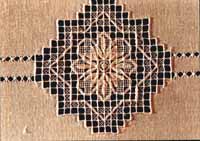 Fancy-work of Nizhegorodskaya oblast appeared at the end of the 19th. At first embroideresses worked for buyers who provided St. Petersburg and Moscow shops with goods. They embroidered in stitch of white colour and decorated their embroidery with simple patterns, such as "pshentso", "mushka" and others. At the beginning of the 20th century "guipure" and ' Japanese stitch" were employed. Fancy-work of Nizhegorodskaya oblast appeared at the end of the 19th. At first embroideresses worked for buyers who provided St. Petersburg and Moscow shops with goods. They embroidered in stitch of white colour and decorated their embroidery with simple patterns, such as "pshentso", "mushka" and others. At the beginning of the 20th century "guipure" and ' Japanese stitch" were employed.
In the early years of the Soviet power local embroideresses began to work in cooperation with each other. Katunki artel, one of the first embroidery artels of that time was founded in 1924 and up to the 1960s it was independent. Later Nova, Purekhov and other artels were set up. In 1937 an artel named after Chkalov was founded in Chkalovsk, and in 1960 it was transformed into Chkalovsk embroidery factory, which combined several artels together, including Katunki one.
The ancient settlement Katunki is located on the bank of the beautiful Volga river. "Po vydergu', a kind of stitch embroidery made at hand, was used here from the end of the 18th century, all women and children were engaged in it. Nowadays a Public Limited Company keeps on embroidering 'Gorky guipure', which first appeared in Katunki settlement.
Gorky guipure is embroidered in white hemstitch. It is different from cross-stitcher as it is open-work. It contains many geometrical figures in the shape of rhombuses, but their corners are round. Geometrical figures are combined with elements of vegetation, such as twigs of berries, leaves and others.
Gorky guipure has some characteristic features, such as long stitches made with the usage of soft white threads. When using machine all stitches are made diagonally in the oblong shape. The technology of embroidery developed in the 18th century became traditional and it is possible to create real Gorky guipure only by hand.
Gorodets painting
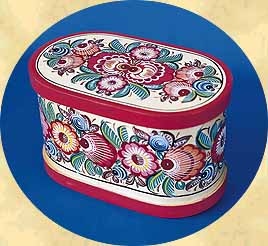 On the left bank of the Volga river, not far from Nizhny Novgorod, there is Gorodets, a large village founded in the 12th century. The territory along the Volga river was favourable for trade, there was Makariyevskaya, the greatest Russian fair. The population began to develop different kinds of craft; in Gorodets itself there were smiths, spice-cake cookers, and dyers. But there was a big amount of carpenters and woodcarvers: the wood was rich in cheap raw material, all the products were sold in the town itself or at "Makariya". On the left bank of the Volga river, not far from Nizhny Novgorod, there is Gorodets, a large village founded in the 12th century. The territory along the Volga river was favourable for trade, there was Makariyevskaya, the greatest Russian fair. The population began to develop different kinds of craft; in Gorodets itself there were smiths, spice-cake cookers, and dyers. But there was a big amount of carpenters and woodcarvers: the wood was rich in cheap raw material, all the products were sold in the town itself or at "Makariya".
Peasants of all neighboring villages were engaged in this craft: some people cut out spoons, others sharpened bowls and cups, and the third part produced tools for spinning and weaving. On the territories situated near the Volga river flax came up, women spinned, and weaved canvases for sale, therefore carvers and painters had plenty of work.
For a short period of time painters mastered painting. Though images are basically flat, instead of treatment of light and shade shimmering tints and colours were employed in painting. Image detail, precise lines and clarity of portrayal were depicted masterly.
Small sized ware or utensils (salt-cellars, boxes for baby toys), as a rule, are painted with patterns of vegetation in which roses, leaves, branches and plumage are of white colour. In decorative panels there are either two or three different scenes or one picture. People are pictured in costumes with features of last century clothes. If an image object is shown to be inside a building, the interior of rooms reminds of some ancient architecture with quaint columns, arches, and other space contains vegetative ornament. That's why there is an impression of idleness, smartness due to contrasts, bright colours and mythical pictures.
Today traditional national 'Gorodets painting' is developing as the art of decoration of flat surface in the historically formed centre which gave birth to it. Such kind of painting enables foremen to use different forms, colours and shades without using heat treatment. Multiplicity of palette is boundless and for 60 years already the foremen of "Gorodets painting' factory keep and develop traditions of the national craft.
Gzhel
 There is a group of about thirty villages located not far from Moscow bearing the name of Gzhel, which has long been famous for its white-burning clay. Gzhel must have been the name of one of these villages. There is a group of about thirty villages located not far from Moscow bearing the name of Gzhel, which has long been famous for its white-burning clay. Gzhel must have been the name of one of these villages.
The origin of this name is somehow connected with the verb zhech - "to fire, to burn". The place has always been the center of folk pottery and has played an important role in the history and development of Russian ceramic arts. Traditionally, Gzhel has supplied clay to many factories and produced excellent pottery famous all over the country.
The history of Russian pottery begins with Gzhel majolica of the eighteenth century, which was followed in the nineteenth century by half-faience, porcelain and thinly wrought faience. It took Gzhel only about fifty years to take up all principal types of earthenware.
The most appealing among the wares of Gzhel are masterfully performed koomgans, kvassniks (pitchers for kvass, a kind of traditional Russian non-alcoholic beverage), diverse and original in form.
Moreover, almost all the population of Gzhel participated in producing majolica pottery, plates, pitchers, bratinas (loving-cups), wine scoops, mugs, ink-pots and other, more decorative festive wears, such as dishes, jugs shaped like a two-headed eagle.
Minor sculptural forms also were of interest in Gzhel ceramic works.
Pottery-painting on Gzhel majolica is close to the folk style of "lubok". Each painted object is a creation of a potter, who was often a simple, illiterate peasant; but his simple practice didn't come into contradiction with a high degree of artistic accomplishment which combined the master's experience of nature, of town and country life, of artistic impressions from architecture, iconography, tile-painting and "lubok" with his own imagination and fantasy. There are two peculiar compositional trends in Gzhel pottery decoration, a three-unit composition with the emphasized central motif under the spout and a panoramic composition with rhythmical arrangement of designs around the vessel body.
The developed specific system of Gzhel majolica painting was conventional and frontal-flat, with further expansion of stylistic drawing of the new art. Alongside of traditional technique of minor plastic, the art of Gzhel sculpture was created.
The old traditions were influenced by new trends of Soviet decorative art, which shed the traditions of easel-painting and turned to idiosyncratic means and to its conventional decorative idiom. However, during the Soviet period most attention was paid to national folk traditions.
In the 1980s Gzhel art was, as always, based on traditional artistic principles inherited from old masters and formulated in the time of Soviet rule. On the whole, Gzhel art includes stylistic uniformity and individual variations, which helped to create various styles and diverse artistic manners developing in the frame of a common artistic system.
An important feature of Gzhel pottery is integrity of form, which is emphasized by painting. However, time and development of artistic styles change the character and themes of painting. Initially, the potters produced mainly utilitarian works, but at present artists feel entitled to artistic creations which are emotionally strong and imbued with sophisticated associations, which are able not only to beautify our life but also to transform it.
The modern art of Gzhel is an active artistic trend with its ups and downs, and with the search of new ways. We may expect its flourishing and success if the masters continue to turn to the heritage of the old times and preceding periods, to find it in the source of education and inspiration and to treat it with deep respect.
Mezen Paintings
 The paintings was of great importance in design of Russian North izbas (peasant households) fronts and interiors. The folk artists ornamented by paintings a majority of everyday articles. These articles accompanied a man from birth up to a great age, and carried in his life the joy and beauty. Unfortunately, time is destroyed a great deal of these decorative paintings and only individual fragments reach us. Among them there is no totally identical ones, although the paintings might be like by style, manner of performance, and colour. The paintings was of great importance in design of Russian North izbas (peasant households) fronts and interiors. The folk artists ornamented by paintings a majority of everyday articles. These articles accompanied a man from birth up to a great age, and carried in his life the joy and beauty. Unfortunately, time is destroyed a great deal of these decorative paintings and only individual fragments reach us. Among them there is no totally identical ones, although the paintings might be like by style, manner of performance, and colour.
M ezen paintings, as well as a many of other folk handicrafts, received its name according to locality, where it was conceived. The Mezen river is between the North Dvina and Pechora rivers, on the taiga and tundra line.
M ezen paintings by its nature is the most ancient one among the russian artistic handicraft industries. Its sources are lost in the remote ages, in the initial period of the Slavic tribes forming. Peak of the handicraft popularity dates from the XIX century. At this time Mezen distaffs and baskets of bast were widely practised in the vicinity of Pinega river, and exported to the Pechora, Dvina, and Onega regions.
T hemes of the Mezen paintings, laconic and expressive stylized drawing bring it together the ancient rock drawings of the Russian North. The restrained colour, where the black outline emphasizes the strained sounding of the brownish-red colour, resembles unwittingly paleolithic cave paintings of France... Brightness and multi colourness traditional for the Russian folk art are unusual to the Mezen paintings. Ornaments have stingy and relative graphic form.
A rtist creates a design in conformity with his inherent mood, and his consideration for future owner of handicrafts; nevertheless the design is submits to the strict rules of ornament construction and to the symbols meaning.
T he Mezen paintings was realized by a carbon-black and clay, dissolved in the infusion of the larch resin. The use of stick and heath-cock feather indicate a very anchient traditions. The board of a very precise proportion should be used: its width must be three times lesser than the length. The structure of oak became apparent after impregnation the board with a linseed-oil. Tracery of the grains determines, to a large extent, the feature of ornament consisting of the symbols, just as the words are formed from the letters. The inherent content of symbols, their origin and correlation are already, for the most part, lost.
L ately one began to use a fashion method - painting on the gold background. This is unsuccessful attempt to please the mass buyer. Following this innovation, the refinement, strictness, and originality of style are disappear. Giving age-old traditions up will lead to the handicraft degeneration.
Unfortunately, only few people are engaged in the renewal of Mezen paintings. It may be seen only in Zagorsk museum or directly in Mezen
Nothern Folk Costume
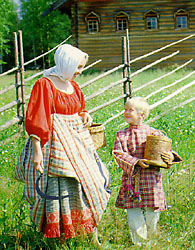 Here we display the collection of Northern folk clothes of the Archangel Wooden architecture Museum. The collection numbers to six thousand beautiful pieces of folk Russian art. For 20 years (and this is how old the museum is) its scientific workers have done to a lot of expeditions to study and to collect exhibits in various districts of Archangel region. Here we display the collection of Northern folk clothes of the Archangel Wooden architecture Museum. The collection numbers to six thousand beautiful pieces of folk Russian art. For 20 years (and this is how old the museum is) its scientific workers have done to a lot of expeditions to study and to collect exhibits in various districts of Archangel region.
Clothes of the end of the 19th and the beginning of the 20th centuries are represented in the collection of the Museum most completely. The women's clothes are prevailing in number. As for art design they are more expressive than the men's ones.
Studying the collection you will find out the most typical features of the Northern folk costume. The way to dress was in compliance with habits and customs of the Russian countryside. Northern costume was also in tune with the appearance of the peasants and their mode of life. Workday clothes were loose and with the dropping cut-lines. They were comfortable, sewn of home-made cloth. Holiday costume was first to be influenced by the town and European fashion.
Pavlovsky Shawls
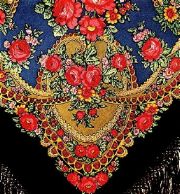 Pavlovsky Posad is an ancient Russian town, situated about sixty kilometers from Moscow, widely known as the home of hereditary textile workers. To be more precise, the town is known for its printed woolen cloth shawls and kerchiefs. In 1996 the Textile Finishing Factory of Pavlovsky Posad celebrated its 184th anniversary. Pavlovsky Posad is an ancient Russian town, situated about sixty kilometers from Moscow, widely known as the home of hereditary textile workers. To be more precise, the town is known for its printed woolen cloth shawls and kerchiefs. In 1996 the Textile Finishing Factory of Pavlovsky Posad celebrated its 184th anniversary.
All the recipes, the method of dyeing, the techniques of printing were treasured by craftsmen as trade secrets passed from one generation to the next in the family. At times, the secret died with the artisan.
A typical feature of the designs in Pavlovsky shawls can be seen in the vegetable ornament. It usually consists of various flowers with leaves. Most often the flowers are roses, clearly outlined and skilfully arranged. Meadow flowers are also very popular, such as poppies, cornflowers and daisies. Sometimes the vegetative forms are interwined with lace designs and other tracery fitting nicely into the pattern composition.
The flowery ornaments are so realistically reproduced that one becomes conscious of a three-dimentional effect.
As a rule, the emphasis in the composition is laid on the corners, where the comparatively larger forms are, or the smaller forms joined together (in a nosegay, for instance). The arrangement of forms in the corners is made adequate in scale with the small forms (small flowers and buds) scattered here and there in the middle. Other variants in the composition of vegetative ornaments are quite possible.
With every year the wonderful art and craftsmanship of Pavlovsky masters is exerting a growing influence on many other kinds of decorative applied art and producing a stimulating effect on the work of many textile enterprises in this country. This may be judged by the fact that many firms in other countries do not only imitate the traditional character of decorating Pavlovsky shawls with their Russian flowery motifs, but simply copying the best models.
Russian Lubok
 "No national culture can be fully understood without such a phenomenon as the folk print" (Alla Sytova) "No national culture can be fully understood without such a phenomenon as the folk print" (Alla Sytova)
The lubki (sing. lubok), simple printed pictures colored by hand and often called broadsides, popular prints, folk prints, folk etchings, or folk engravings, are a vivid and fascinating page in the history of Russian culture. Folk prints were known in many other countries (in the Far East as early as the eighth century and in Western Europe from the fifteenth); in Russia they appeared in the middle of the seventeenth century and survived until the beginning of the twentieth. The origins of their Russian name have not been yet clearly determined, but the following four possibilities are usually suggested:
The word lubok may derive from lub, the thin layer of wood under the bark of a mature lime (linden) tree. Lub was only about an inch thick and could not be used for deep carving, but, pressed and dried, served in Old Russia as a popular material for light construction and for writing. Up to the nineteenth century it was common in villages to use the lub panels, covered with ideograms, as boundary markers, debt contracts, and even letters. It is possible that these simple lub images inspired later pictures printed on paper.
In younger trees, the layer of wood under the bark (bast) was much softer and thinner, but it was also called lub. Since bast was used in Russia for centuries as a material suitable for weaving baskets and shoes and for painting objects made of it with brightly colored designs, some specialists derive the lubok's name from this use.
To make the problem even more complex, in Central Russia, the limewood, soft and easy to carve, and used for making the woodblocks, was also called lub. Perhaps the name of the final product (the print) comes from the name of the material (limewood) itself.
Finally, some lubok scholars suggest that the name derives from the woven bast baskets, since the street hawkers and vendors of the prints carried their wares in such baskets; even today in Russian the woven bast container for berries is called lubianka. Others disagree with this etymology, claiming that the vendors themselves did not call the prints lubki, but used different names, which referred either to the origins and provenance of the prints (friazhskie, suzdal'skie -- from the "West," from Suzdal), to the way they were made (prostoviki -- simple or crude things) or to their themes (bogatyri, konnitsy, prazdniki - mighty heroes, horseback riders, saints' feasts).
A contemporary viewer is amazed and surprised by the lubok's bold colors, expressive lines, balanced composition, a certain naive simplicity of the drawing, the encyclopedic scope of the topics and the inclusion of large amounts of text in many of the pictures. The specific lubok style is a combination of Russian icon and manuscript painting traditions with the ideas and topics of western European woodcuts. Western prints proved to the Russian artists that print-making was an effective way of disseminating multiple copies of images, and provided them with many subjects and compositions. From icon painting the lubok inherited the tradition of making the most important figures disproportionately large in relation to the others, using no aerial or mathematical perspective but rather a perspective based on multiple points of view, and called, for the lack of a better word, inverted or reversed. Moreover, the unity of time was as easily violated in lubok as in icon composition. One picture often showed several moments of the same story with the hero or heroes appearing in several places. Finally, the lubok was bright and cheerful like many Novgorodian and Northern icons influenced by folklore. The prints were colored with tempera, the paint used by icon painters; but in the print coloring, tempera was thinned out to the consistency of watercolor, which allowed the drawing to show through. The favorite four colors were red, yellow, green, and purple. The earliest prints were pressed from wooden boards. Because the material did not permit the artists to include in their pictures extensive details or large amounts of text, compositions of woodcuts were monumental and clear, uncluttered and expressive. The introduction of copper engraving early in the eighteenth century dramatically extended the ability of the prints to inform, teach, and amuse since the copper plates were a much more precise vehicle to render complex subjects with many figures and many lines of explanatory text. However, in the process of transition from woodblocks to copper plates, the prints lost their compositional clarity, balance of design, and brightness of color. At the same time, the quality of the coloring decreased; dealing with many copies of the same print, the colorists sometimes used broad patches of paint to cover elaborate designs without regard to the outlines and details.
Throughout its relatively brief existence, the lubok responded to the changes in the life of the country and became a popular way of expressing people's feelings about daily events, beliefs, customs, mores, and ideals. It was aptly called "a kind of mirror of the people's soul".
Covering such a great variety of topics, the lubok cannot be divided easily into thematic categories. The greatest collector and cataloguer of the prints, Dmitrii Rovinskii, developed a very detailed classification. According to him, the major categories of lubki were icons and Gospel illustrations; the virtues and evils of women; teaching, alphabets, and numbers; calendars and almanacs; light reading, novels, folktales, and hero legends; stories of the Passion of Christ, the Last Judgement and sufferings of the martyrs; popular recreation including Maslenitsa festivities, puppet comedies, drunkenness, music, dancing, and theatricals; jokes and satires related to Ivan the Terrible and Peter I; satires adopted from foreign sources; folk prayers; and government sponsored pictorial information sheets, including proclamations and news items (after Hilton 110). To facilitate this overview of the rich lubok material, Rovinskii's categories can be condensed into following broader lubok subjects: religion, satire, everyday life, clowns, jesters and fools, information and news, literature, and miscellaneous topics that include astrology, images of animals and birds, advertisements, fortune-telling, and pictures of the world turned upside-down. This classification is not exact; sometimes the borderline dividing the subjects is rather thin.
For instance, The Moneylender's Pleasant Dream can be classified as a satire on loan sharks and pawnbrokers. On the other hand, if one keeps in mind how widespread and common the business of pawning and lending money at high interest had become by the middle of the nineteenth century in Russia (cf. Dostoevsky's Crime and Punishment), and if one pays attention to various "realistic"details in the picture, the print can also be considered a scene from everyday life.
Russian porcelain
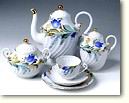 The Imperial porcelain plant was established in the middle of 18 century, was named after Mikhail Lomonosov, one of the Russian-s porcelain creators. First porcelain had the same quality as Saxon-s and Chinese ones. At first the plant produced tiny goods: snuffboxes, coffee and chocolate caps, Easter eggs, plates, trays, candlesticks. Later appeared ceremonial table-sets. The most famous among them are "Arabesque" for 60 persons, which consists of 973 objects, "Gurievsky" table-set, which was ordered for tsar-s family. In total, for that table-set were produced 4500 objects, for decorating were used several kilograms (hundred pounds) of gold. The major part of this table-set is now in the collection of Pavlovsky Palace-museum. The Imperial porcelain plant was established in the middle of 18 century, was named after Mikhail Lomonosov, one of the Russian-s porcelain creators. First porcelain had the same quality as Saxon-s and Chinese ones. At first the plant produced tiny goods: snuffboxes, coffee and chocolate caps, Easter eggs, plates, trays, candlesticks. Later appeared ceremonial table-sets. The most famous among them are "Arabesque" for 60 persons, which consists of 973 objects, "Gurievsky" table-set, which was ordered for tsar-s family. In total, for that table-set were produced 4500 objects, for decorating were used several kilograms (hundred pounds) of gold. The major part of this table-set is now in the collection of Pavlovsky Palace-museum.
Porcelain with label you can see in the Hermitage, the Russian Museum in Saint Petersburg, State Historical Museum in Moscow, banquette halls of Kremlin and Russian Orthodox Church Patriarch-s residence. In the Albert and Victoria Museum in London, in the Metropolitan Museum in New-York and other museums all over the world.
Things made of birch-bark
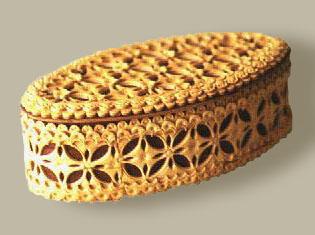 Birch-bark is a unique natural material. From time immemorial in ancient Russia it was used for manufacturing of various household subjects, such as dug-outs, boxes, caskets, baskets for salt, groats, flour, grains, berries, cedar nuts. Birch-bark is a unique natural material. From time immemorial in ancient Russia it was used for manufacturing of various household subjects, such as dug-outs, boxes, caskets, baskets for salt, groats, flour, grains, berries, cedar nuts.
In specially made boxes there were liquids: milk, sour cream, cedar oil, adipose, honey, salted fish and many other things. All these products could be kept for infinitely long time, because birch-bark is bactericidal. For example air in birch wood is more sterile, than in operating-room. Bags, clothes, footwear were made of specially processed birch-bark, which was not worse than leather goods.
Birch is believed to be a warm tree. Even in a cold room it is handwarm, because is has positive power. It is enough to look at it, to hold it in your hands - and it will take your troubles away. One can hear women talk that birch-bark relieves you of your weariness, and normalizes blood pressure if you spend much time working at the computer. Goods made of birch-bark are ecologically clean, as they are made of natural materials by hand. Almost each thing is unique.
Decorative processing of wood in Russia was known in the 9th and 10th centuries. In Russia, rich in woods, everybody liked tree and many generations of foremen used it. Surprising properties of birch-bark were considered irreplaceable in the life of peasants. Birch-bark was used for manufacturing of utensils. Birch-bark boxes were made for milk, sour cream, fish and meat. This material is famous for its solid, flexible, rot-proof characteristics.
Many Russian provinces manufactured birch-bark products. In the 18th century already cut birch-bark was used as an ornament.
Birch-bark is stored in May and June because it is the time when it has all nutriments. Then it is elastic, easily peeled off tree trunk, if you stamp it there appears a deep figure with soft edges.
Foremen make different sets from birch-bark (beer mugs, mugs for kvass and other drinks, trays, kvass-pots) using carving and stamping, in combination with each other they make things harmonious. Craftsmen skilfully modifying patterns make each subject unique.
Tula Samovar
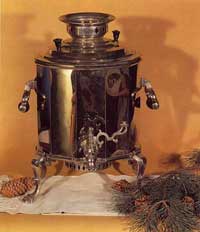 Samovars are a necessary feature of the Russian mode of life and consequently a part of Russian applied art. It is difficult to say when the first ever samovar was made, but they became widely spread throughout the country with the introduction of tea and coffee. Samovars were produced in many towns of Russia, but most famous was Tula, an old center of metalworking. Samovars are a necessary feature of the Russian mode of life and consequently a part of Russian applied art. It is difficult to say when the first ever samovar was made, but they became widely spread throughout the country with the introduction of tea and coffee. Samovars were produced in many towns of Russia, but most famous was Tula, an old center of metalworking.
The earliest samovars resembled English tea urns or tea vessels. They had already the principal characteristic element - a tube situated inside and a wind box, but a spout and a carrying handle instead of a tap. Later, at the end of eighteenth century, samovars began resembling vases and antique urns.
Russian samovars vary in interior construction and exterior decoration and purpose. They were made of different metals - copper, iron, silver, silver plating on copper, steal, cast iron, and their decoration testifies to different stylistic art trends echoing the general tendencies in the artistic tastes of different periods.
The samovars became the symbol of Russian hospitality and family comfort as well as the sign of prosperity. Step by step a peculiar ritual of tea-drinking emerged and was adopted in every Russian home. In compliance with it, a hostess or her elder daughter poured the tea. Some families held two samovars, one, more plain, for everyday use, and a dearer one - for receptions and festivities. There were homes with separate samovar-rooms whose interior was crowned by the samovar.
Valdai Bells
 Delicate and pure sound of Valdai bells has been pleasant to human hearing more than 500 years already. Have you ever heard their melodious sound? Do you know their history referring to ancient times? Delicate and pure sound of Valdai bells has been pleasant to human hearing more than 500 years already. Have you ever heard their melodious sound? Do you know their history referring to ancient times?
According to a beautiful legend, Valdai bells first appeared in 1478. That time the veche Novgorod bell was ordered to be taken from the Sofia belfry and sent to Moscow by Tsar Ivan the Third so that it sounded in harmony with all Russian bells and did not preach freedom any more.
But the prisoner failed to get to Moscow. On one of the slopes of Valdai mountains the sledge with bell slid downhill, the scared horses galloped back, the bell fell off the cart, dropped down into a ravine and smashed to pieces. First Valdai bells were cast from these pieces.
Another legend (there are lots of them) says that Valdai bells were first cast in the 17th century. In 1656 state craftsman Alexander Grigoriev cast Nikonov bell in Iver monastery. He gave pieces of bronze left from casting of the bell to the Valdai people who helped him. Since then, they say, bells have been cast in Valdai. Bells must have been cast in the 17th century already, but only in the second half of the 18th century the real Valdai (i.e. road) bells appeared. In the first place, these bells were necessary in Moscow and St. Petersburg high road, Russia's busiest road. Production centre was set up in Valdai situated in the centre of this high road.From immemorial time, local masters were famous for forging and they began to cast first Valdai bell.
In the beginning of the 19th century special bell workshops and plants appeared. First signed and dated bells refer to 1802. Phillip Tersky, Alexey Smirnov, Ivan Smirnov and Nikita Smirnov created bells that year. It is well known that Valdai is the first centre of road bells casting. A technology of their production differs from casting of church bells and was first developed in Russia. That's way one can fairly call Valdai bell casting a pure Russian national thing.
Valdai casting following road bells were cast in Slobodsky town (Vyatskaya guberniya), Tyumen, Kasimov (Ryazanskaya guberniya), Purekh settlement (Nizhegorodskaya guberniya) and other places.
Road bells served as a signal providing safety in road and a musical instrument for a coachman. Bells were swaying to the rhythm of movement of horses sometimes making them skip faster or enabling to have a rest while galloping.
The bells informed about coming of a chariot to the station and helped in many other respects so that a traveller couldn't do without it taking into account the conditions of Russian roads.
As said before, the history of Valdai bell casting existed in words up to the end of the 19th century, therefore the main source of knowledge is studying bells themselves, signs, dates and names of founders put on them. Valdai bell has a fixed constant (classical Valdai) form, which is a combination of equal correlation of measures of height and diameter that makes an impression of steadiness. Bells are deprived of decor as such what makes them look simple and functional and the most important thing is a sign put always in one and the same place, the bell's edge, the latter being called 'skirt' by local masters.Streamline and smooth form, peculiarities of a sloping top which is named "shoulder", the form of a "sundress", and especially "skirt" emphasize not only anthropomorphism of Valdai bells but indicate that it has shapes of a woman dressed in a Russian sundress. Valdai bells have certain characteristic features, among them originality of a loop for hanging of a clapper, forged clapper itself, places made smooth in combination with not sharpened rough strips.
In spite of the fact that they cost much money the value of Valdai bells was in high quality of a product (high-grade Ural copper was used), beautiful sound and tradition in everything, beginning with the legend about their appearance from the Veche Novgorod bell.
Vologda lace
 Vologda lace is a kind of Russian lace tatted with bobbins. Continuous smooth line, which never crosses and forms a pattern of Vologda lace, is a woven braid ('vilushka') over a thin openwork grid. Vologda bobbin lace tatting dates back to the 16th and 17th centuries, but the craft itself was developed in the 1st quarter of the 19th century. Vologda lace is a kind of Russian lace tatted with bobbins. Continuous smooth line, which never crosses and forms a pattern of Vologda lace, is a woven braid ('vilushka') over a thin openwork grid. Vologda bobbin lace tatting dates back to the 16th and 17th centuries, but the craft itself was developed in the 1st quarter of the 19th century.
Nobody knows how this wonderful craft appeared in Russia. Different researchers give contradictory answers to this question. Holland, Germany and even Spain can be justly considered ancestors of Vologda lace. As a matter of fact, it is not so important whose ship was the first to deliver precious lace to Russia. Precious in its direct meaning. Foreign lace was tatted from golden strings meant only for people who wielded authority.
But Russia is an unpredictable country. If an English mechanical flea should fall into the hands of our foremen it will be grounded. Before the ruling clique had time to show off foreign valuables, our foremen made lace on their own: golden meant for richer people and silver for people of moderate means; iron for those who cannot afford noble metals. Later provincials heard about this novelty. (Considering that a clever tongue will take you anywhere in Russia). Hundreds of foremen of different regions began to create different patterns of lace. Then they began to apply partially forgotten linen thread and impressed the whole world with snow-white, as light as down, Russian lace.
Country lace-makers began to tat at an early age. Lace-makers earned 20 rubles a year. That time decent sum of money. Suffice it to say that at the end of the 19th century kg of oil cost 50 copecks, and meat only 14. However, there were few people who tatted lace for sale that time. They made it for themselves or for a present. If a girl inherited a lace from the mother or grandmother, it was possible to sell it and get hammered silver-plated ear-rings; a dozen of spindles, and a pair of good combs instead.
It is rather difficult to learn to tat lace but it is more difficult to make it up. And before a girl tats the first lace kerchief another lace-maker should put her heart and soul into this work. Lace design is unnoticeable and almost forgotten work. Almost nobody knows, what wonderful secrets these people have.
Two threads are used in weaving: basic and shot wires; one is used in knitting, and lots of threads in tatting. Sometimes their number can amount to 60 and even more. Each string is winded around a separate bobbin, a kind of stick. Pleteya, it was the name of a lace-maker, fixes a string on a bobbin, puts it on her knee and rolls it out a little until a thread takes its place. After it kuftyr is used, a kind of drum stuffed with straw and made of textile fabric. It is fixed on a special support, previously having been wrapped up with paper peaces, which are very important in lace making. Inserting pins into holes and throwing over bobbins, pleteya interlaces threads. Like a computer punched card determines computer program, a peace of paper determines a lace pattern.
Vologda has always been one of the main centres of Russian lace tatting, and in the 19th century it became the most famous one. It was that time when lace-makers began to tat lace patterns in the form of wonderful stars and snowflakes. Vologda lace reminds of hoarfrost on winter glass, which will disappear under the first rays of the March sun. It looks like a thin spider line, which will be torn by a waft of wind. They are like symbols of something innocent and momentary. Like a madonna lily, Vologda lace could become a symbol of innocence.
In fact, in old times brides used to tat lace for dowry by themselves. The bride's house was always decorated with lacy "postilalniks", "ubruses", special towels, and "naspichniks" for a groom to come. And lace tatting itself was called "female scheme".
Zhostovo
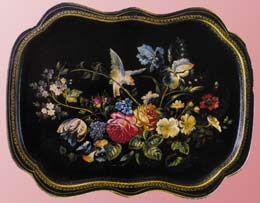 Zhostovo is a world-famous Russian folk art center popular for its painted trays decorated with bright bunches of flowers on the black background. The skillful and talented masters of Zhostovo have turned these domestic utensils into real masterpieces of art. Zhostovo is a world-famous Russian folk art center popular for its painted trays decorated with bright bunches of flowers on the black background. The skillful and talented masters of Zhostovo have turned these domestic utensils into real masterpieces of art.
The first workshop of tray painted decoration was opened in 1825. Soon tray painting became an independent handicraft.The following types of lacquered wares were made there: boxes, cases, snuff-boxes and other articles of papier-mache. The first trays were also made of papier-mache decorated with troika-driving, genre scenes, landscape and floral ornamentation.
Later this material was substituted by metal, while decorative brunch of flowers replaced floral ornament. Thus, the original style of Zhostovo painted decoration had formed about the middle of the nineteenth century.
The style and methods of Zhostovo painted decoration have acquired peculiar traditions of folk art ornamentation and realistic still-life painting.
However, the tendency of painting bunches of flowers became leading. Today, after more than 170 years existence of the handicraft the village of Zhostovo turned into a unique center of Russian folk art. The floral designs of Zhostovo trays display beauty of nature and a cheerful, optimistic sense of life.
The best traditions of this popular folk art are preserved by modern artists of Zhostovo, who manage to unite the traditional methods with improvisation and individual talent of each master.
Nowadays the works of Zhostovo artists are on display at various exhibitions and museums not only in Russia, but in many other countries of the world.
|